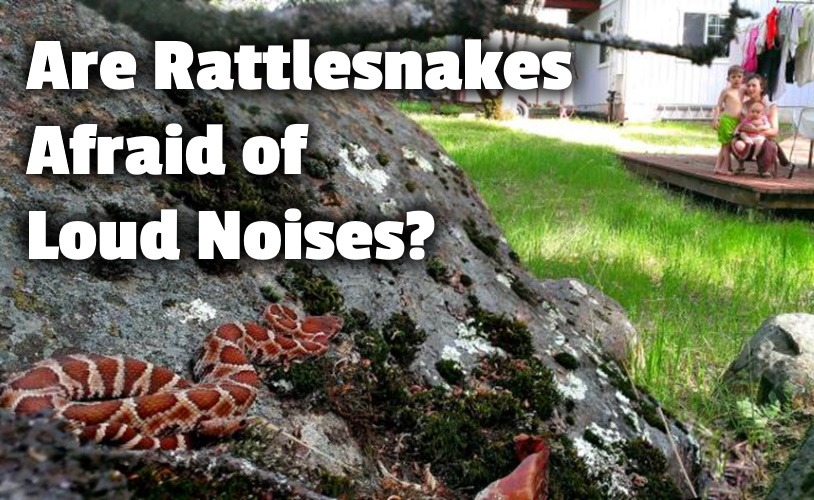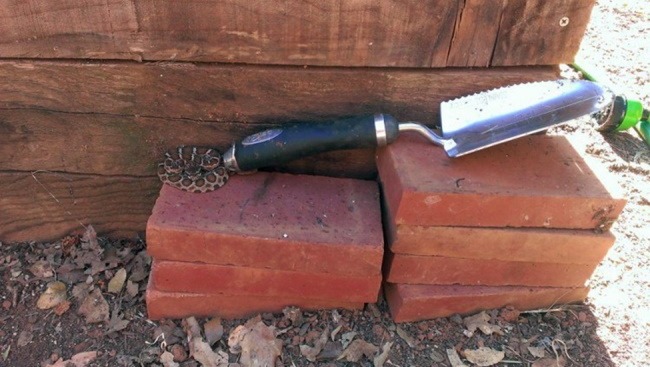
Where I live we get a lot of rattlesnakes in my yard. With 2 young kids, I’m always looking for ways to scare the snakes away. But I wondered, are rattlesnakes afraid of loud noises?
I decided to research the idea and here’s what I discovered:
No. Rattlesnakes don’t hear the same way people do. They are, however, sensitive to vibrations so you can definitely scare a rattlesnake away by stomping or doing other things that shake the ground or area around where they live.
Rattlesnakes do not have ears as we do.
So in this article, we’ll explore how rattlesnakes respond to both noise and vibrations. After all, when they rattle, they are scared too. They don’t want to get attacked and you don’t want them to attack either.
So let’s get into it, learn how to safely respond to them, and maybe even do that without feeling the need to kill the snake.
Observing #rattlesnake pups at communal rookeries has allowed us to notice that many of them have odd patterns, including fused blotches. Could this be becoming more common, or has it always been a thing? 🧐
Photos by Spencer Riffle pic.twitter.com/ykkRn8m3QK— Project RattleCam (@Rattlecams) May 21, 2021
So how do rattlesnakes hear?
Rattlesnakes do not hear the way humans do. Their ears have evolved over thousands of years to be very sensitive to vibrations in the ground which are made by the footsteps of large animals in the Americas, such as deer, elk, or bison.
After all, if a large animal were to step on a rattlesnake by accident, that could seriously injure or even kill it.
In fact, this is probably why rattlesnakes evolved their distinctive rattle in the first place: to warn large animals not to step on them.
When a rattlesnake feels the vibration of a large animal approaching, it may slowly move away, being careful not to turn its back on the approaching animal. If the animal is approaching too quickly, the rattlesnake will stop and go into a defensive position where it can rattle its tail and strike if necessary to defend itself.
A rattlesnake’s sensitivity to vibration can work in our favor because they will try to avoid areas where there is a lot of activity and vibrations in the ground.
Such an area will feel unsafe and uncomfortable to a rattlesnake and it won’t want to make a permanent home there. However, this doesn’t mean you will never find a rattlesnake there.
In the springtime when some rattlesnakes are looking for new homes, they may move across busy areas and you may have an encounter with one.
Saw my first timber rattlesnake this week! Absolutely incredible camouflage! pic.twitter.com/uSf8CUAs2v
— Riley Thoen (@Thoen_Riley) May 21, 2021
Are snakes sensitive to noise?
No, snakes are not sensitive to noise compared to human beings or other animals. Although snakes do have ears, their ears are designed very differently and are not nearly as sensitive as our ears are.
Although snakes are not sensitive to noise vibrations in the air, they are very sensitive to noise vibrations that shake the ground or objects around them.
For example, if you have a pet snake and you’re listening to loud music with lots of bass that shakes the terrarium of your snake, your snake will definitely “hear” that and could even get stressed out by it.
In this situation, it’s more the vibration rather than the noise that snakes are feeling, similar to how deaf people can still “hear” music by placing their hands on a stereo speaker.
Some deaf people enjoy dancing to music when the music is loud enough that they can feel the vibrations coming up from the floor. In this situation, it is mostly the lower frequency bass notes and drumbeat that deaf people are perceiving since these sounds produce more vibration than higher frequencies.
In a similar way, if you’re stomping across the ground you will be producing “bass notes” that will alert snakes to a possible danger approaching them.
Stomping your feet or striking the ground with a walking stick will produce a much more noticeable vibration than talking loudly or yelling.
In fact, some snakes may not move at all when yelled at. This also means that if you want to catch a snake, try to walk gently so it is not alarmed by your approach.
A cool animal rescue in Sedona let me hold the rattlesnake 🐍 pic.twitter.com/BNYmN3spFb
— Alyssa (@alysssa_11) May 18, 2021
What scares away rattlesnakes?
The number 1 thing that scares away rattlesnakes is something you might not expect: a lack of food. Removing the major sources of food for rattlesnakes, which are primarily small lizards, rats and mice, birds and even some insects, the rattlesnakes will eventually leave to look for a more plentiful food supply.
Just like any other animal, if a rattlesnake cannot find enough food in a particular area, it will move on to more fertile hunting grounds.
This is why the number one way to scare off rattlesnakes is to take away their food supply.
Around your home, the best way to do this is to remove rats and mice. These rodents love to live in or around homes where they can build safe nests and find food, so make sure to rodent-proof your home as a first measure.
You can seal small openings to your home with expanding foam or wire mesh to prevent rodents from getting in. You should also set out traps to kill any rodents that are already living in your home.
Make sure to keep your pet and people food sealed and out of reach of rodents.
Although cats are not a top predator of rattlesnakes, they are the top predator of the rattlesnake’s food supply: rodents, lizards, birds, and other small animals.
This is why having a feral cat on your property (one that must hunt for its own food rather than eat store-bought cat food) is one of the best ways to get rid of rattlesnakes.
If a feral cat has eaten most of the small animals on your property, rattlesnakes will leave on their own, since they will not have enough food to survive.
Some feral cats will even kill rattlesnakes directly, just keep in mind that they can also be seriously injured or even killed by rattlesnakes, although most cats will survive a rattlesnake bite if they receive emergency medical care (source.)
A rattlesnake on the trail today. Watch out while hiking or biking! pic.twitter.com/p8I0mPs5fZ
— Paul Bernstein, MD (@sdthinkbig) May 15, 2021
Does clapping scare snakes away?
No, the sound of clapping will not scare a snake away, since they are unlikely to hear it very well. However, depending on the type of snake, moving your body around in an animated way may scare the snake away.
Because snakes don’t hear sound vibrations in the air very well, clapping is not an effective way to scare them away.
Instead of clapping, try stomping your feet on the ground to produce vibrations that the snake will feel. This will be more effective than clapping.
Another important thing to keep in mind is that when you’re stomping your feet or moving around in an animated way, be sure to give the snake enough room so that it will feel safe enough to flee.
Many snakes don’t like to turn their backs to an approaching threat, whether a human or another animal, because they can’t easily bite while they are slithering away.
Because turning their back and fleeing is a more vulnerable position for them, if you are too close they might decide it is safer to stop and turn towards you to fight.
They might even move towards you and attack!
How a snake reacts also depends on the type of snake. Some snakes can move very fast and use their speed in fleeing as their best defensive weapon. Others, like a rattlesnake, may choose to stand their ground and fight as their best defense.
In my personal experience, rattlesnakes are more likely to fight than non-poisonous snakes.

Do vibrations keep rattlesnakes away?
Yes, vibrations keep rattlesnakes away to some extent. Generally speaking, rattlesnakes will try to avoid areas with lots of activity that cause vibrations in the ground, such as people, animals, machinery, or vehicles, but that has to be balanced with other factors in the environment.
If all things are equal, rattlesnakes will try to avoid high traffic areas with lots of ground vibration, just as other wild animals will.
However, this is not an absolute rule.
There are times of the year, especially in spring, when rattlesnakes might be on the move. Baby rattlers, in particular, may be moving across your property as they look for a territory of their own.
You can imagine my surprise when I went to work in my garden and found a baby rattler coiled up next to my hand trowel (see pic above.)
I’m glad I looked before I reached!
Even though I was working frequently in my garden and was moving rocks and dirt around with a wheelbarrow, this baby rattler still chose to coil right at the center of some frequent activity.
In fact, it is mostly baby rattlers that I found sitting out in the open, in high traffic areas, like this.
They are most likely looking for a territory to call their own, and they haven’t learned to conceal themselves and avoid high traffic areas yet. Older rattlesnakes typically conceal themselves better and are harder to spot.
(Snakes) Aruba Island Rattlesnake pic.twitter.com/ws7D169qtU
— 🌱🐞Nat’s Snaps🐞🌱 (@Deer_Head_Snaps) May 16, 2021
What repels snakes?
The more sure way to repel snakes is to remove their food supply and leave them a few places to hide. If you do that they will not want to stay in your area. Although there are products on the market which promise to repel snakes, it is questionable whether they work or not.
I will write more about commercial snake repellents in a future article, but for the time being, I am very skeptical whether these products really work.
I would not entrust the safety of my family to a manufacturer’s claims that their products work, since their claims may be driven by profit rather than actual results.
Reading reviews on snake repellents can be a little more helpful, but then some sellers create fake reviews.
I’ve also read many reviews from people who give a product 5 stars and say that they haven’t seen any snakes when using the product.
The absence of snakes is not proof that a repellent works, and may be due to other causes.
For example, it might be a time of year when snakes are not as active during the day and so people aren’t seeing them even though they are still there.
What to use instead of snake repellants
Instead of trying a repellent that may or may not work, I recommend the more practical and proven method for repelling snakes: make your property inhospitable to them.
This means picking up the random objects in your yard which provide hiding places for both the snakes and the small animals that they eat.
Trash, lumber piles, rock piles, pieces of plywood, old vehicles, or other equipment all make good hiding places for both rattlesnakes and rodents.
As you can see in the photo above, there is a baby rattlesnake coiled in a play area for my kids that had tall weeds nearby and lots of toys and debris where it could hide.
The weeds in this picture were at the top of a rocky hillside which housed a lot of rodent dens, which was evident from the acorn shells and rodent poop that we found there among many small holes. Not coincidentally, this is also where we found lots of rattlesnakes!
After this experience, I made sure to cut the weeds and pick up the clutter. I also began to take rodent removal more seriously and took measures to reduce the rodent population.
Final Thoughts
My research taught me that rattlesnakes are not scared of loud noises and will not leave a property or run away from loud noises.
Although they do possess a type of ear that allows them to hear, their ears have evolved to be much more sensitive to vibrations in the ground than sound vibrations in the air.
Because rattlesnakes are very sensitive to vibrations in the ground they will try to avoid high traffic areas because they don’t want to get stepped on and crushed.
At the same time, it is important to remove hiding places and the food supply if you really want to make your home inhospitable to snakes in general and rattlesnakes in particular.
